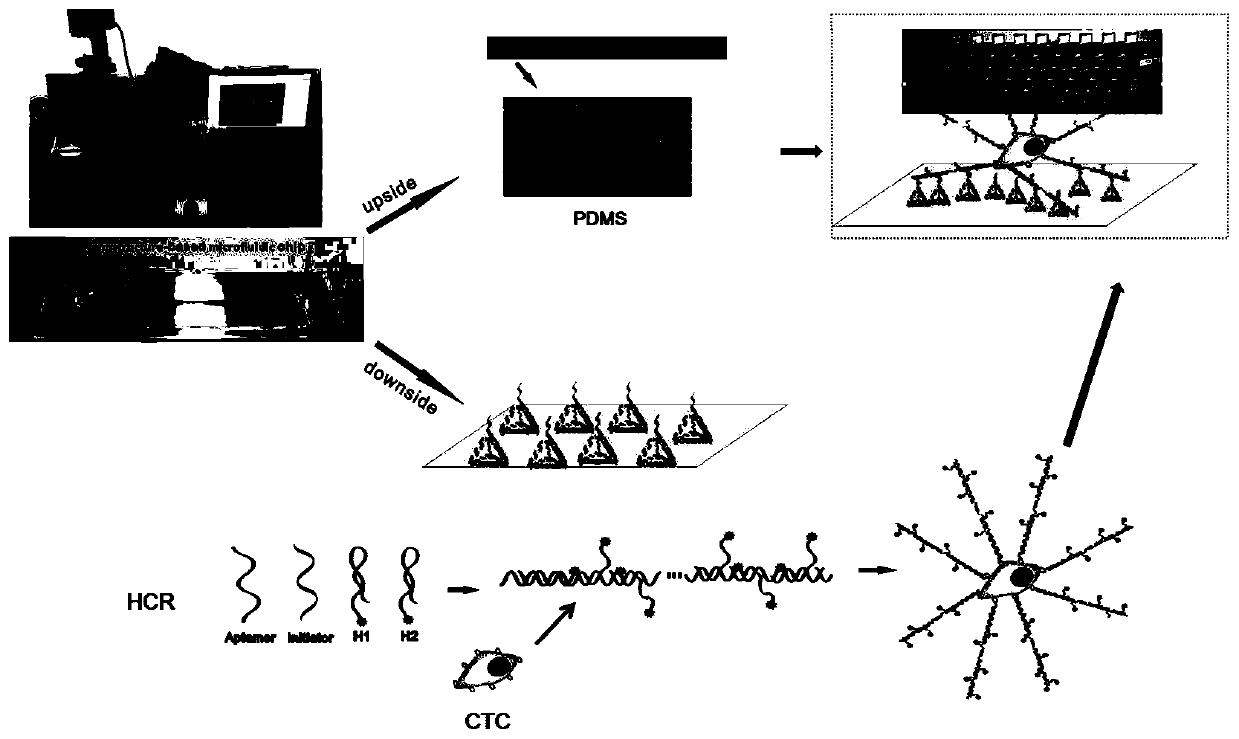DNA nanostructure-modified microfluidic chip for optical biosensing and preparation and application of DNA nanostructure-modified microfluidic chip
A microfluidic chip and nanostructure technology, applied in biochemical equipment and methods, bioreactors/fermenters for specific purposes, microorganisms, etc., can solve the problems of cumbersome operation and low detection efficiency of circulating tumor cells, and achieve high sensitivity High, specific, and easy-to-operate effects
- Summary
- Abstract
- Description
- Claims
- Application Information
AI Technical Summary
Problems solved by technology
Method used
Image
Examples
Embodiment 1
[0070] (1) Materials and equipment
[0071]The electrophoresis devices were all purchased from Bio-Rad; the PCR instrument was Peltier thermal cycler PTC-200 (MJ.Research Inc., SA); the UV gel instrument was G:Box (gene Company Limited); -3010); fluorescence spectrophotometer (Hitachi F-4500); HD-850 desktop horizontal flow clean bench purchased from Shanghai Sujing Industrial Co., Ltd.; fluorescence confocal microscope (Leical, SP8); total internal reflection fluorescence microscope (Leical); inverted fluorescence microscope (Leical); flow cytometry (BD array).
[0072] (2) Construction of microfluidic chip system modified by DNA tetrahedron
[0073] Construction ideas: The microfluidic chip is divided into upper and lower layers. The lower layer of the chip is decorated with a DNA tetrahedral structure. The DNA tetrahedral structure can be combined with the HCR hybridization chain reaction to achieve signal amplification. The initiator chain in the HCR structure can be hybr...
Embodiment 2
[0083] Example 2 Detection limit and linear range of microfluidic chip modified by DNA tetrahedron
[0084] Different numbers of MCF 7 cells (10, 100, 1000, 10000, 100000) were captured using the aptamer-HCR-DNA tetrahedron structure prepared in Example 1 and the fishbone microfluidic chip. Add different amounts of cells into the probe solution, incubate with shaking on ice for 30 min, wash with BB three times, calculate the capture rate respectively, and obtain the detection limit and linear range. The specific calculation method of the capture rate is: the cells combined with the HCR-aptamer probe are incubated and washed, which is called the stock solution; the same cells combined with the HCR-aptamer probe are incubated and washed, and then passed into the microfluidic channel to collect the captured liquid and become the recovery solution , use a fluorescence microscope to observe and count the cells in the original solution and the recovered solution, and the amount of c...
Embodiment 3
[0086] Example 3 DNA Tetrahedral Modified Microfluidic Chip Detection of Purity
[0087] Mix 1 mL of the two types of cells (MCF7, Hela) in equal amounts, add to the probe solution, incubate with shaking on ice for 30 min, and wash with BB three times. Under different cell numbers (100, 1000, 10000), the optimized aptamer-HCR-DNA tetrahedral structure probe in Example 1 and the channel of the fishbone microfluidic chip were used to capture and calculate the capture purity. The specific calculation method of purity is: MCF7 / Hela cells combined with HCR-aptamer probes are incubated and washed, which is called stock solution; the same MCF7 / Hela cells combined with HCR-aptamer probes are incubated and washed, and then passed into the microfluidic channel to collect and capture The final liquid becomes the recovery solution. Use a fluorescence microscope to observe and calculate the number of MCF7 cells in the original solution and the recovery solution. The amount of captured cell...
PUM
| Property | Measurement | Unit |
|---|---|---|
| length | aaaaa | aaaaa |
| length | aaaaa | aaaaa |
Abstract
Description
Claims
Application Information
 Login to View More
Login to View More - R&D
- Intellectual Property
- Life Sciences
- Materials
- Tech Scout
- Unparalleled Data Quality
- Higher Quality Content
- 60% Fewer Hallucinations
Browse by: Latest US Patents, China's latest patents, Technical Efficacy Thesaurus, Application Domain, Technology Topic, Popular Technical Reports.
© 2025 PatSnap. All rights reserved.Legal|Privacy policy|Modern Slavery Act Transparency Statement|Sitemap|About US| Contact US: help@patsnap.com



